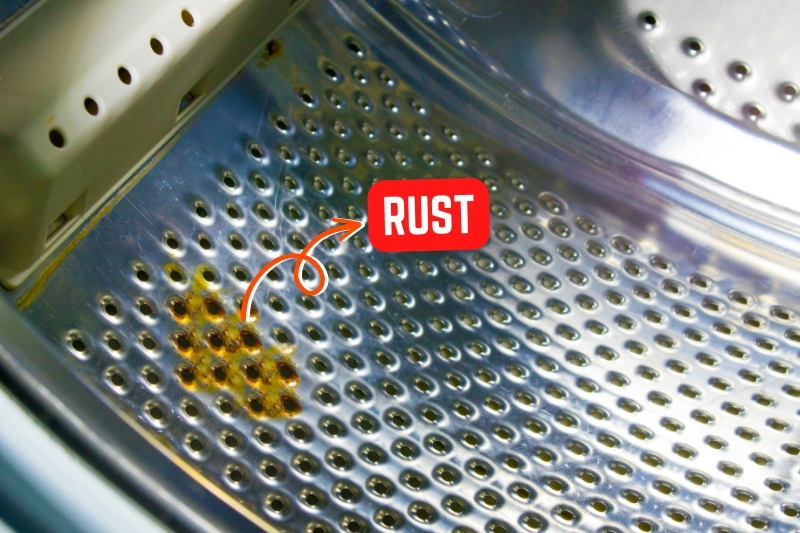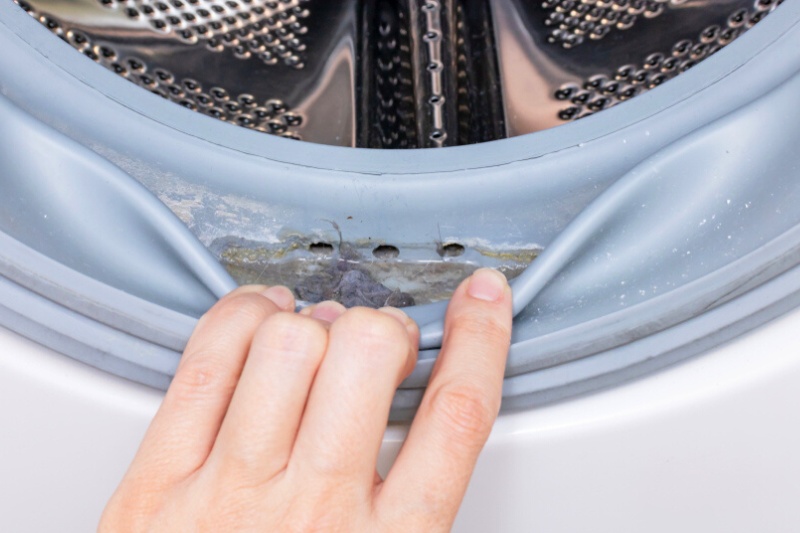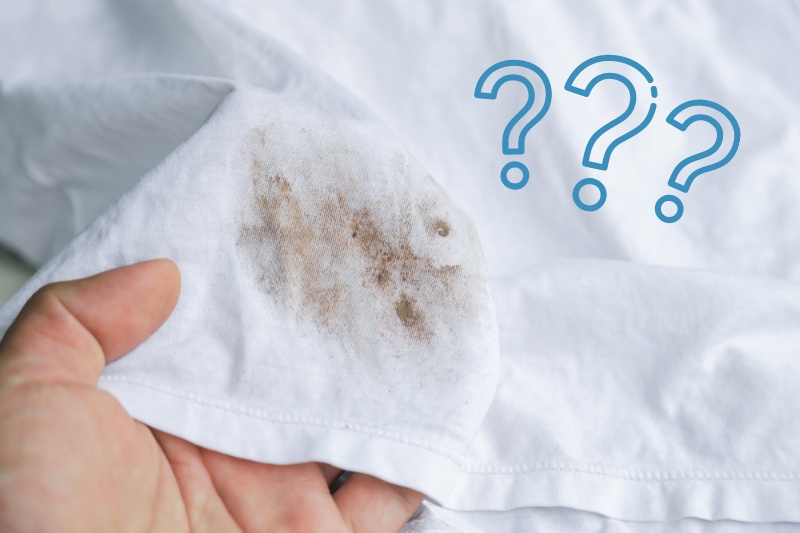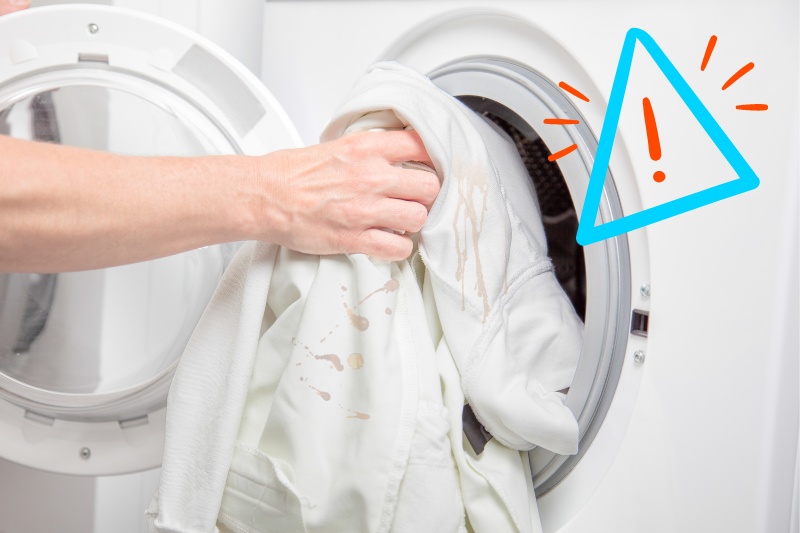We rely on washing machines to clean our laundry, leaving it feeling and smelling fresh. After all, that is what washing machines were designed to do!
It can be confusing, therefore, when you notice that your clothes leave the machine worse than when they went in.
One of the common complaints from homeowners is washing machines leaving brown marks on clothes.
What is the cause of these brown marks? Is the appliance broken? Or is there another issue at play?
Thankfully, we have all the answers you need! Read on to find out what may be causing these brown marks and how to resolve the problem for good.
Even if you have the best washing machine on the market, there may come a time when you notice the appliance leaving dirty brown marks on your laundry.
This is typically caused by one of four issues, each of which we have covered below.
Cause 1: Detergent & Fabric Softener

The biggest culprits of brown marks on clothing are two common laundry products: laundry detergent and fabric softener.
When there is an excess of laundry detergent in your machine, fabric softener combines with it to form a waxy sludge known as scrud.
This most commonly occurs when you habitually use cold wash cycles, as your detergent may not dilute properly before mixing with the fabric softener.
However, it can also come about by merely using too much laundry detergent in each wash.
A build-up of scrud will not only stain your clothes but also cause your machine to give off an unpleasant smell.
You can eliminate any scrud in your machine using dissolved dishwasher tablets. To dissolve dishwasher tablets, mix 2-3 of them into a pot of hot water.
Then add your dishwasher tablet mixture to your machine’s drum, close the door, and put on your washer’s hottest cycle.
If you don’t have dishwasher tablets to hand, 150 grams of citric acid can work in their place.
Cause 2: Rust

The next potential cause of the brown marks is rust.
Unfortunately, your washing machine is an optimal environment for rust to develop. The moisture inside the machine helps iron and oxygen combine to form iron oxide, which is what rust is made from.
As explained below, there are three main causes of rust in washing machines. You’ll need to do a little investigating to see which applies and use the corresponding solution:
- General ageing: Washing machines typically rust over time, especially if not properly maintained. These rusty iron parts will most likely be out of sight, so you will probably need the help of a professional to determine if this is the issue.
- Pennies and paperclips: A more easy-to-see cause is small pieces of metal trapped in the machine and rusted over time, such as coins or paperclips. If either of these turns out to be behind your rust problem, you need to remove them from the machine. Once removed, your clothing shouldn’t come out with brown marks.
- Minerals in the water: Iron or manganese might be present in your water. These molecules can react with oxygen or chlorine bleach found in some detergents to form brown flakes. Try switching to a detergent that doesn’t contain chlorine bleach or oxygen bleach, and see if the problem resolves itself.
Cause 3: Greasy Residue
Every time you use your washing machine, a small amount of residue will be left behind in the drum. This greasy residue is the dirt and grime from your laundry that isn’t drained away at the end of your machine’s cycle.
Usually, this isn’t a problem as the residue will be removed from the drum during regular cleaning. However, inconsistent cleaning of your washing machine will allow the residue to build up in the drum and transfer onto your clothes during washing.
The easiest way to fix this issue is to clean the drum. You can do this by running your washing machine through an empty cycle at the hottest temperature possible.
Instead of using laundry detergent, add white vinegar, bleach, or a specific washing machine cleaner. Once the cycle is finished, wipe the drum and door seals with a clean cloth.
Cause 4: Mould and Mildew

The final thing that may be causing the brown marks on your clothes is mould and mildew.
If there are patches of mould in your washing machine, they will leave stains on your clothes whenever the laundry comes into contact with them.
In washing machines, mould and mildew typically form on the rubber seal (gasket) around the door.
This is particularly true when the water from washing doesn’t fully dry around the seal, as mould can grow as soon as 24-48 hours after a surface is exposed to standing water.
In most cases, you will be able to remove any traces of mould or mildew from your washing machine by cleaning it with white vinegar.
However, your machine’s gasket is likely faulty if the mould keeps coming back. In this instance, a new seal must be fitted else the problem will continue to reoccur.
How Do I Stop My Washing Machine Leaving Brown Marks on Clothes?

As you can see, there are plenty of reasons why your washing machine may leave brown marks on your clothes.
No one wants their clothes to be ruined by such stains, but thankfully, there are some things you can do to prevent any of these issues in the future.
1. Clean your washing machine regularly
Firstly, thoroughly clean your washing machine at least once a month to remove any greasy residue or scrud left behind during a previous load.
2. Don’t overload the machine
You also need to ensure you don’t overload your machine during washes, as this will stop your laundry detergent from properly dispersing, increasing your scrud build-up.
Using the correct amount of laundry detergent is also crucial for avoiding scrud.
3. Don’t put metal items in the wash
To prevent rust, we recommend checking your clothes for spare coins, paper clips, and other objects before putting them in the wash. This will also help your machine to last longer.
4. Leave the door open so the drum can dry out
Finally, always leave the washing machine door open after use so the inside can dry properly. This helps to prevent mould and mildew from growing inside the gasket.

Hannah has a passion for cleaning. She worked her way around Australia by cleaning hostels in exchange for free accommodation and used her cleaning skills to bag a job as a chalet host for a luxury ski company in France.






